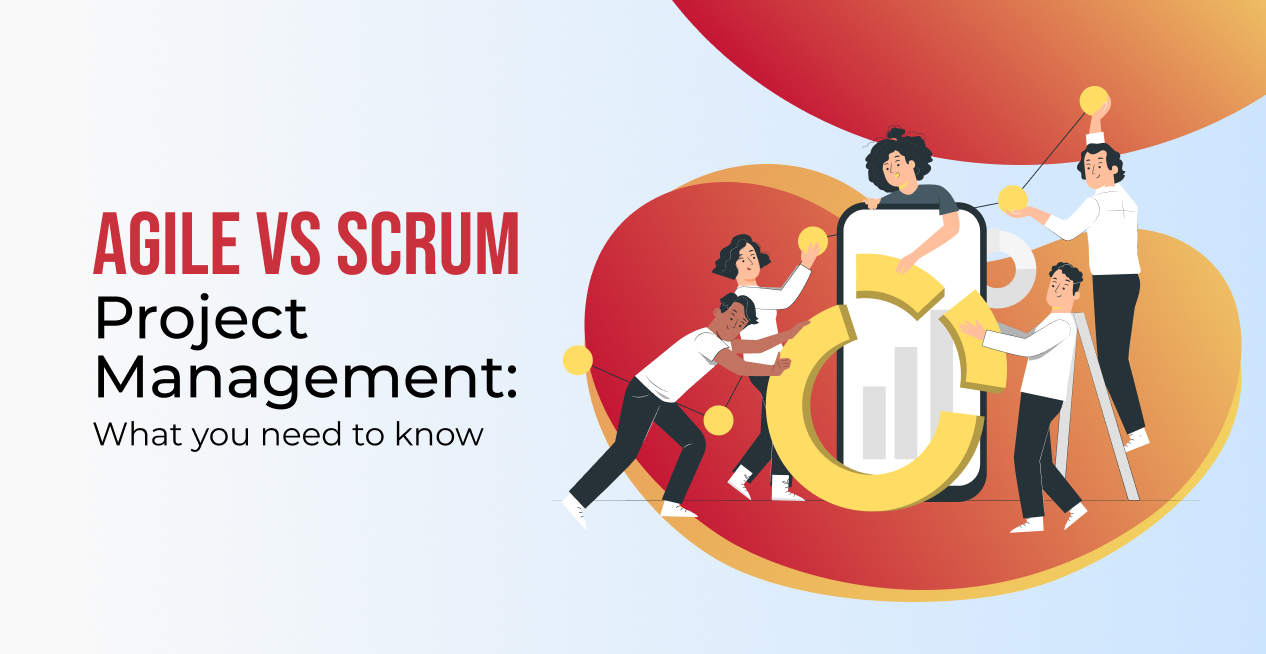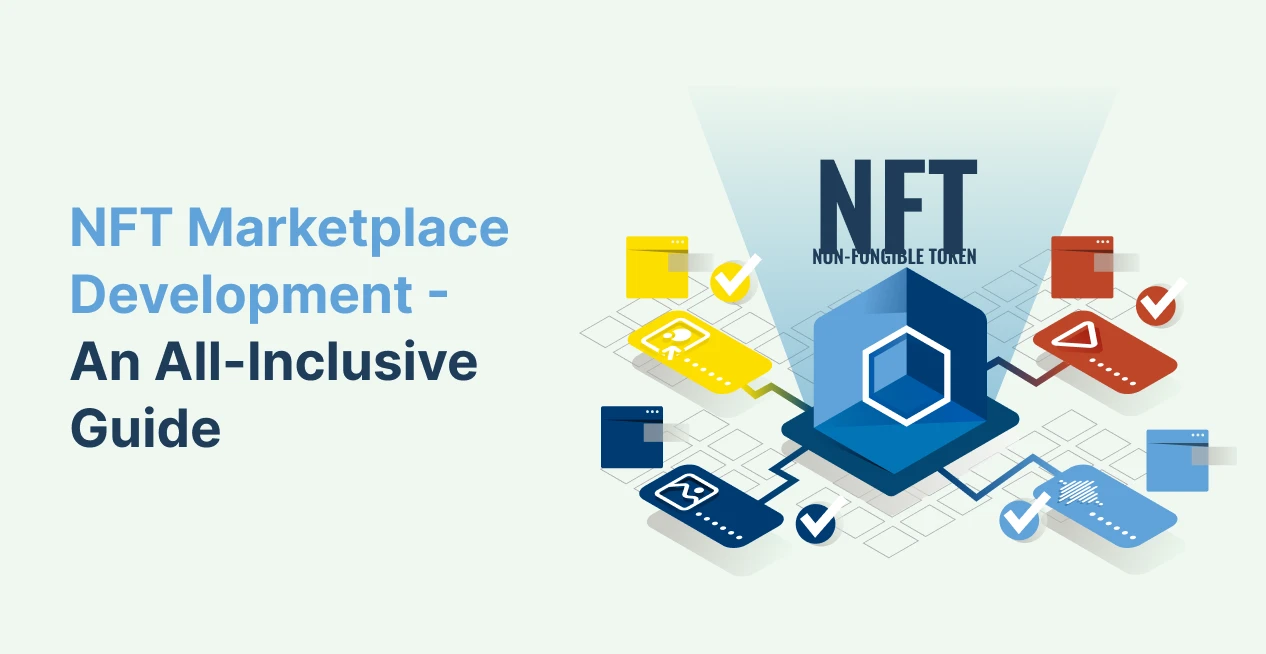What is Agile vs Scrum
Agile vs Scrum: If you work in the Agile or Scrum field, it’s likely that you already know at least one of these phrases. You may also be curious about the difference between Agile and Scrum. The term “Agile and Scrum” are often used interchangeably in modern DevOps environments because of their similarities. However, practitioners must be aware of the differences between Agile and Scrum. Agile has been a common methodology for developing software for more than 20 years, and it still is today. Moreover, Scrum has become a viable solution for product development because it has a few advantages over Agile.
To better understand Scrum vs Agile, it’s helpful to know more about how Scrum and Agile methodologies work. But first, you must learn what Agile is, and what is Scrum?
Agile vs Scrum: A Quick Comparision Table
| Aspect | Agile | Scrum |
| Flexibility | High | Moderate to High |
| Roles | Self-organized teams, Scrum Master, Product Owner | Scrum Master, Product Owner, Development Team |
| Sprints | Not mandatory, can vary in length | Fixed length (usually 2-4 weeks) |
| Deliverables | Incremental and iterative | Potentially shippable product increment |
| Meetings | Adaptive to team needs | Daily Stand-ups, Sprint Planning, Sprint Review, Sprint Retrospective |
| Artifacts | Depends on the methodology used (e.g., Kanban, XP) | Product Backlog, Sprint Backlog, Burndown Charts, Increment |
| Focus | Value delivery, customer collaboration | Iterative development, team collaboration |
| Documentation | Emphasis on working software over comprehensive documentation | Minimal documentation, focus on transparency |
| Changes Management | Embraces changes throughout the project | Changes managed within sprint boundaries |
| Scalability | Can be applied to various types of projects | Best suited for smaller to mid-sized teams/projects |
What is Agile?
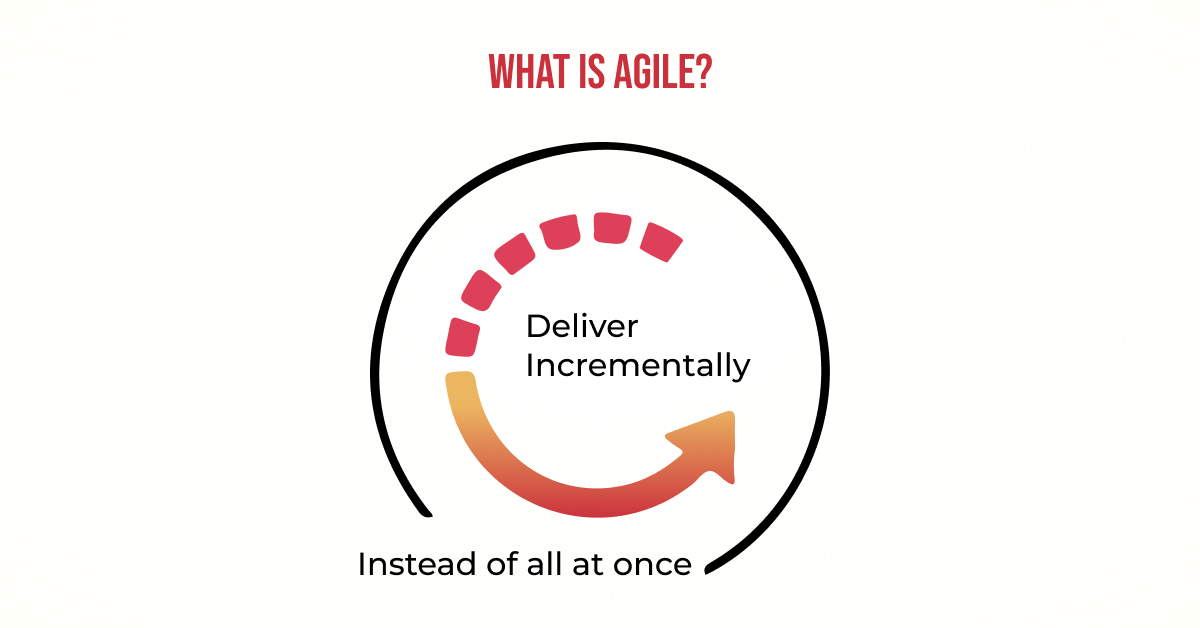
Agile Methodology is a collaborative and flexible approach aimed at increasing team efficiency. This widely used project management approach is often a more natural way to keep cross-functional team members organized and on task. The team works on a project through a series of iterations using Agile, which is then prioritized based on the feedback of the end-user.
A simple explanation of Agile using an example-
Agile’s incremental development methodology sets it apart from previous project development methodologies. Agile projects are delivered in parts, instead of working on a project from beginning to end and delivering the finished product after it has been fully completed.
Consider how it would feel if you were required to develop a mobile application. Start with features, including the ability to create an account and log in. According to the priorities set by the client, more functionality will be introduced over time. This guarantees that development is consistently concentrated on the most important features, allowing the client to see the value of the deliverable quickly.
Agile pros and cons:
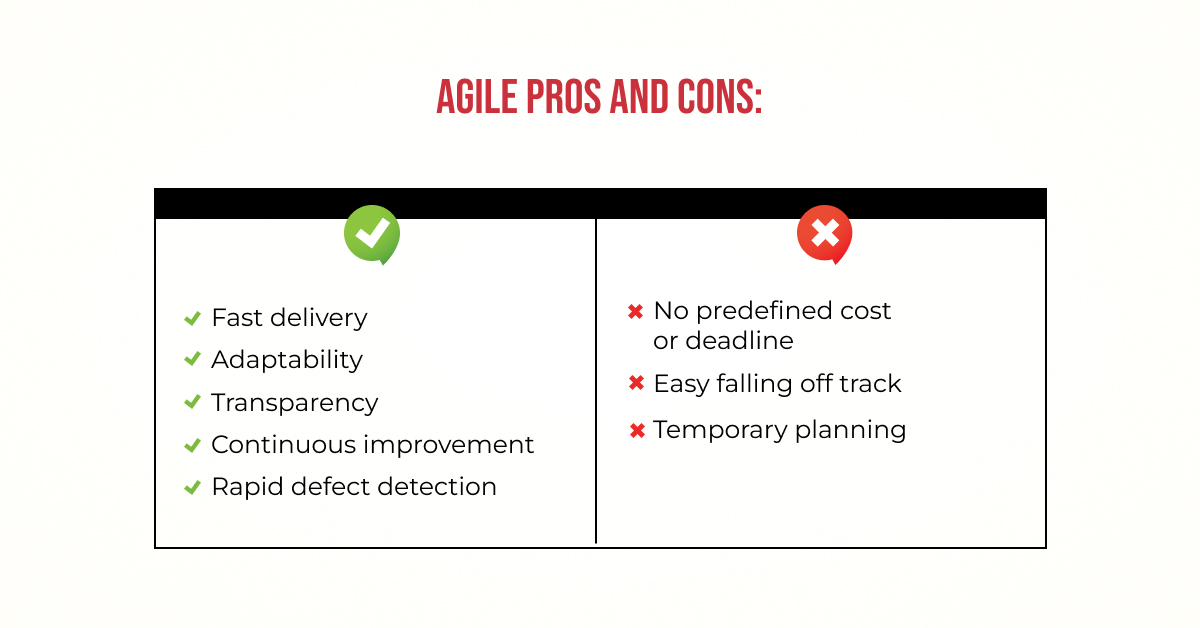
The pros of Agile Project Management
1. Fast delivery: Agile means team members will complete each minor increment of the product backlog more quickly through a series of iterative cycles. As a result, the development team can build a product more quickly and effectively using Agile methods.
2. Adaptability: Every iteration of the Agile development process allows for flexible modifications without affecting previous work. This characteristic distinguishes Agile from a traditional approach.
3. Transparency: The Agile development process is transparent from ideation to testing and launch because many team members in various roles contribute to it. Members also keep a close eye on all the work to ensure it progresses as planned and nothing is hidden.
4. Continuous improvement: A product’s UX/UI design and features can be evaluated and optimized in real-time in the Agile methodology. This helps to save a lot of time and money when changing a product’s features or fixing errors. One can constantly improve the product based on the client’s feedback without creating an entirely new version.
5. Rapid defect detection: Working in small steps not only enables simple improvements but also enables your team to pinpoint issues quickly and precisely. In addition, one can immediately fix problems and defects, such as the design or key features of a mobile app.
The cons of Agile Project Management
1. No predefined cost or deadline: It is common for agile teams to have difficulty understanding how long each iteration will last or how much the entire project will cost. This is because of the unexpected changes during the development process. When budget deadlines are not specified, final products may be delivered later than planned, resulting in additional costs.
2. Easy falling off track: It is easier for projects to go off course or exceed the scope of the original project due to the less-structured nature of Agile Methodology. Thus, your team may not develop a coherent product that adheres to specifications.
3. Temporary planning: In many ways, the agile approach is more reactive than proactive. Real-time problem-solving and feedback processing is vital. This implies for many people, careful preparation should not be addressed in a rush to respond, adapt, and advance. To ensure that your long-term vision gets noticed in the process, you need a strong core vision.
Which industries use Agile Methodologies?
Agile was developed to speed up project completion in the software development industry, but other sectors have adopted it as well. Have a look at the industries that use agile methodologies.
Agile in banking and finance
The banking sector has adopted Agile approaches to develop efficient software for handling consumer transactions. Financial organisations have been using Agile methodologies to ensure that the development teams are on the same page when addressing the feature requirements for the website or application.
Agile in government agencies
Agile could assist in breaking down big government projects into manageable parts from the beginning, resulting in better outcomes. The biggest challenge in making Agile approaches effective is getting all constituencies to cooperate without becoming bogged down in red tape.
Agile in healthcare
Healthcare firms are able to update features that aren’t performing as planned by utilising Agile methodologies. Additionally, the sector can adopt agile methods like Scrum, where weekly sprints can be used to guarantee privacy and security even as new features are being released.
Agile in advertising and marketing
Many startups have found success in the advertising and marketing sector by adopting Agile methodologies. Many companies offer software to help with marketing. Their workflow and approval procedures are automated using the Agile approach.
Agile pharmaceutical companies
Agile enables the pharmaceutical industry to provide value across a range of contexts and supports them in communication, research, and development. The most significant advantages of Agile in the pharmaceutical sector are the promotion of an innovation-oriented mindset, as well as the acceleration of innovations and assistance in achieving success.
What are Agile values and principles?
4 values of Agile Methodologies are:
1. Individuals and interactions, rather than procedures and tools: The Agile method’s first value calls on businesses engaged in designing or developing products or software to put their end users and clients first. User-first thinking characterizes an agile approach. Companies must incorporate customer feedback into their software development processes.
2. Developing software and products are preferred to in-depth documentation: The development of software or products in accordance with client feedback is identified as the second essential value of the agile framework. This contrasts with how project management and software development were traditionally done when the documentation of individual steps was given more weight than the end output.
3. Customer involvement during contract negotiations: The first core value of the Agile methodology states that customer participation takes priority over all organizational procedures and resources. The third value reiterates that clients are crucial to all project management and software development processes. This helps develop products or software that satisfy client needs and boosts an organization’s general productivity.
4. Adapting to change over sticking to a plan: The project plan was the central focus of traditional project management. The entire endeavor works if the planning is effective. According to the Agile methodology, following a plan is acceptable if there is room to adjust it as necessary. Project managers and Agile practitioners must be prepared to adjust to the project’s shifting requirements because change is inevitable.
12 principles of Agile Methodology:
- Emphasis on delivering products consistently while adding value.
- Completing projects on time by organizing the work into manageable, minor tasks.
- A self-organised team is more likely to succeed and have more freedom to make decisions that will make the job easier to complete.
- Throughout the project, business people and developers must collaborate on a daily basis.
- Establish a welcoming workplace that promotes individual engagement.
- Using tools and strategies, keep track of the project’s timeline and progress.
- By enhancing and monitoring each step, you can maintain the quality of your program or product.
- Holding regular meetings to assess the project’s requirements and review its progress.
- Allowing for change at any point during the development of a project or a product.
- Emphasize the importance of value-generating initiatives and ongoing improvement.
- Boost overall productivity using sustainable methods.
- Boost your effectiveness by regularly reflecting and adjusting your way of working.
What is Scrum?
Next, what is Scrum? Scrum Methodology is one of the primary Agile methodology frameworks used by teams to deliver a finished product in a sprint of two or four weeks. Each sprint ends with a review of the finished product and the development of feedback before the next one starts. The iterative process for project completion helps provide the most value to the end user and helps the product get better with each iteration.
It’s interesting to note that the Scrum approach is an Agile framework that promotes efficiency and collaboration in software development and testing. Product backlogs, sprint backlogs, and sprint goals are the three components that make up a sprint in a Scrum-based development project. A particular function is defined, developed, and tested during each sprint. If any business requires a code change, it is quicker and simpler to find it in the sprint backlog than to restart the entire software development lifecycle.
Scrum pros and cons
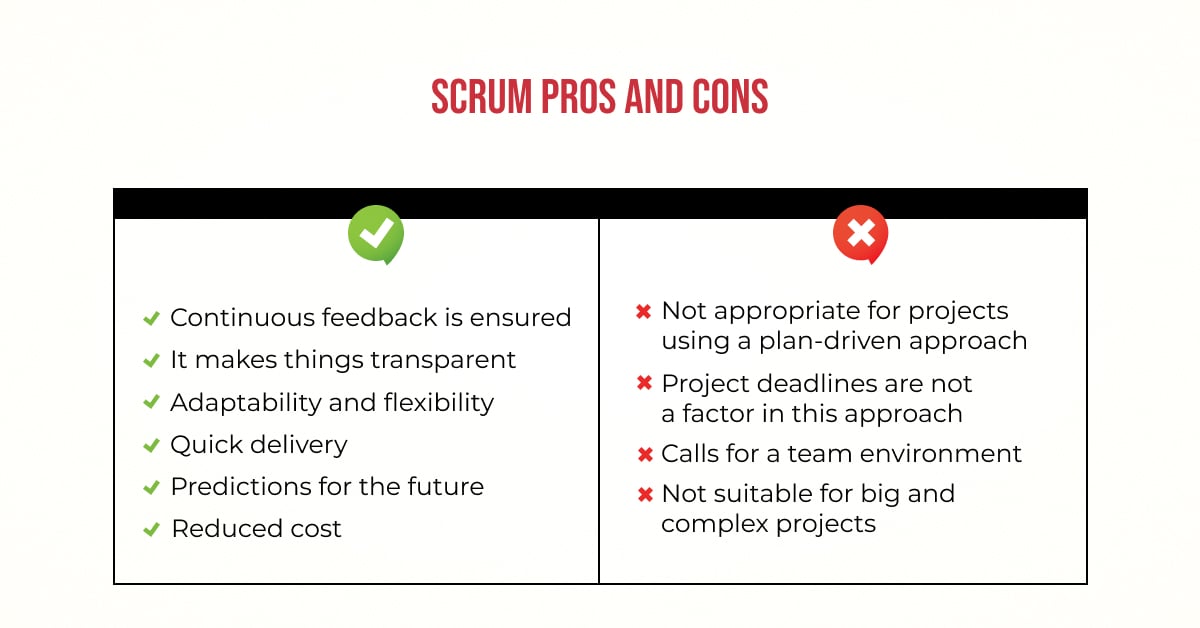
The pros of Scrum Project Management
1. Continuous feedback is ensured: Projects are continuously monitored to guarantee improvement over time at every level. Scrum provides a framework for constant feedback and exposure to ensure the highest possible level of quality.
2. It makes things transparent: The Scrum technique ensures that employees complete their assignments on time, and fosters communication between the organization and its customers. Every member is kept informed of even the smallest changes to any aspect of the project. Transparency builds trust, which results in more customers for the business.
3. Adaptability and flexibility: The scrum methodology works best in situations where there is some degree of uncertainty. It is difficult to know the requirements and potential solutions before beginning a project. The Scrum team may change any project component without affecting the final product to define a project’s requirements, flexibility and adaptability.
4. Quick delivery: As a result of the scrum approach’s quick startup, products are delivered more quickly, resulting in better time to market. A solution section is delivered immediately without necessarily finishing the project.
5. Predictions for the future: By providing the team with an average speed measured in story points, the Scrum approach makes it simple to estimate functionality in the product backlog.
6. Reduced cost: By eliminating unnecessary documentation and controls, the scrum model reduces expenses by cutting back on overhead. As a result, the Scrum team’s productivity increases.
The cons of Scrum Project Management
1. Not appropriate for projects using a plan-driven approach: Scrum primarily applies to projects for which there is no need for in-depth planning or strategies prior to starting the development process. Instead, it assumes that it can determine the product development process using client feedback and other relevant procedures.
2. Project deadlines are not a factor in this approach: The Scrum technique ensures each team member meets their objectives by using personal deadlines. However, it neglects the project deadline, which can lead to delays.
3. Calls for a team environment: The scrum technique is suitable for small groups and calls for a team of at least three individuals. However, the Scrum method doesn’t work very well for more than ten members. This is because having additional people slows down the task by delaying decision-making.
4. Not suitable for big and complex projects: As the Scrum is most effective for small and medium-sized projects, it may not be appropriate for large-scale or complex projects. Businesses using Scrum at the corporate level may run into issues with the method’s scalability. For large and complicated projects, an organization can adopt different scrum models like Less, SAFe, and Scrum of Scrums.
Which industries use Scrum Methodology?
Here are some of the industries that use the Scrum method:
Finance-related businesses
In order to meet client expectations, a growing number of financial service businesses are implementing Scrum. This is in response to increasing difficulties with technology platforms, risk management frameworks, and payment processes.
Education
Numerous universities are realizing that scrum techniques enable them to achieve their objectives effectively. Things can become difficult and disorganized in colleges because there are so many diverse departments and areas of interest. Furthermore, there has never been a more crucial time for various university departments to collaborate cross-functionally. Universities have improved their structure and efficiency by implementing a Scrum model.
Event planning
In recent years, event planning companies have found the Scrum methodology to be quite helpful. Scrum is a solution created especially for event planning firms because of its capacity to make adjustments in real time based on received feedback and a strong iterative structure.
Construction
Large-scale construction projects typically involve huge capital and regulatory risks, as well as demanding schedules. Numerous businesses have opted to plan, create, and carry out their projects using the Scrum approach over the past few years. In particular, Scrum has helped businesses make choices quickly, ensure excellent teamwork and communication, and connect all of their milestones with the ultimate objective.
Automobiles
Some vehicle manufacturers have started using the Scrum Project Management methodology. A Scrum strategy provides a chance to accelerate innovation because the traditional auto sector has a tendency to work in slower development cycles. A Scrum method is being used by an expanding number of businesses and sectors to keep projects moving along in an effective manner.
What are Scrum values and principles?
The five Scrum values are:
1. Commitment: The Scrum team makes a personal commitment to meeting its goals. This commitment goes beyond simply agreeing to meet deadlines and other standards. Even though achieving deadlines is a part of the commitment, the scope extends much further than milestones to encompass the organization’s overall cause and vision.
2. Courage: Team members need to have the courage to take on difficult, intimidating challenges and act morally. Unluckily, a team lacking courage won’t be inventive, imaginative, or successful. This courage includes supporting the Scrum technique and upholding its principles in the face of sceptics or critics.
3. Focus: Scrum teams have one to four weeks to develop the required product increment. To achieve their goals as soon as possible, they must focus on this requirement. Distractions are unfortunately everywhere, and some of them may even appear important enough to deal with right away. At every stage of the project, Scrum team members must stay focused on the objective and the power.
4. Openness: Stakeholders in the project and members of the Scrum team must maintain clear and honest lines of communication. When discussing the necessary workload and the difficulties it presents, both parties should engage in complete disclosure. As a result of this transparency, all parties must build trust.
5. Respect: Each member of a scrum team must respect the views, experiences, and cultural traditions of others. Respect among Scrum team members helps them bond and work together more efficiently. Members must extend this respect to users as well, paying attention to their issues and complaints, making sure the final product satisfies them.
The six principles of Scrum are:
1. Control of the empirical process: As opposed to relying on theory, the empirical Scrum method relies on verifiable data and experimentation. The three essential principles of empirical process control are transparency, inspection, and adaptability.
2. Self-organisation: Self-organisation is important because the Scrum process relies on many people. The self-organization principle encourages more buy-in from all stakeholders while making it simpler to evaluate individual efforts. Everyone in the team is given the freedom to work independently.
3. Collaboration: The several responsibilities involved in Scrum are proof that it is a collaborative process. This principle emphasizes these three aspects of collaboration that are awareness, articulation, and appropriation.
4. Prioritisation based on values: The Scrum team must prioritize tasks according to their significance and value to both end users and business objectives. Starting with the project’s beginning and continuing until it is successfully finished, this prioritization process is one that is constantly evolving.
5. Time-boxing: Time is a valuable and precious resource. Using the time-boxing principle, different tasks are allocated specific amounts of time. Setting aside time for planning and executing projects increases efficiency.
6. Iterative development: This last principle refers to the understanding that a project may need to be modified more than once as it is being developed. Using iterative development, the team can handle changes and adjustments more easily.

Agile vs Scrum: What are the differences?
Let’s dive into the differences between Scrum vs Agile methodologies to determine which approach aligns best with your project requirements.
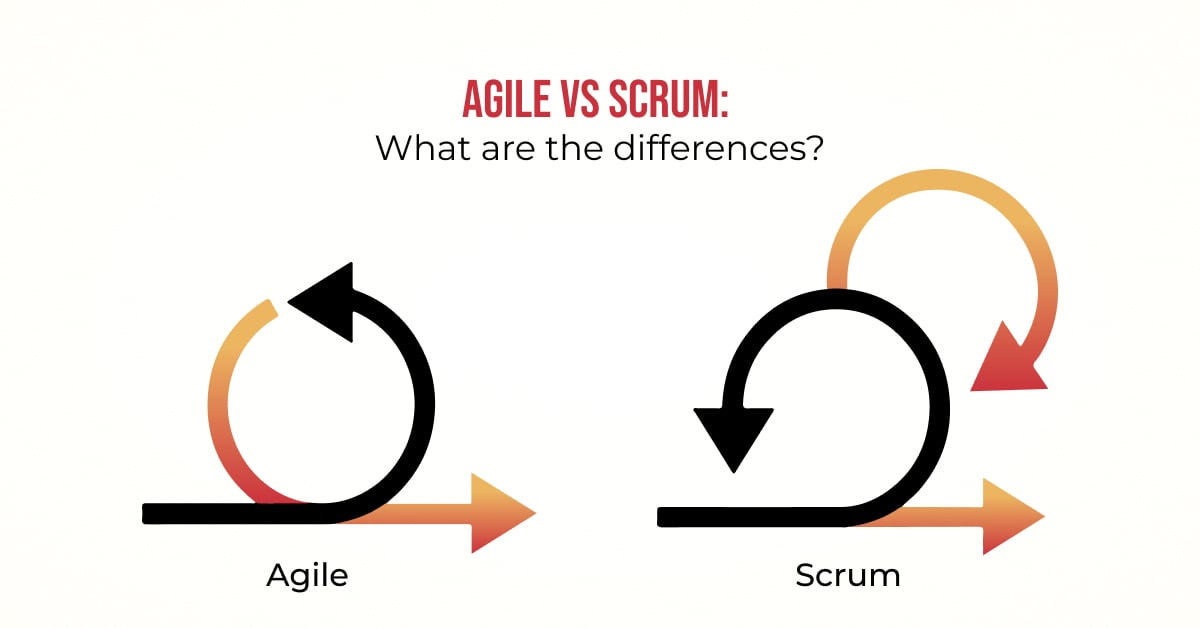
| Agile | Scrum |
| Agile is a development methodology built on an incremental and iterative method. | Scrum is one of the ways the Agile methodology is applied. Wherein the consumer gets incremental builds every two to three weeks. |
| It is a more strict method than Scrum. The potential for frequent modifications is, therefore, limited. | The main benefit of Scrum is its flexibility because it quickly reacts to changes. |
| All tasks in the Agile methodology are managed by the project head. | Since there is no designated team leader, all concerns or issues are handled by everyone in the team. |
| In Agile, software needs to be regularly delivered and upgraded. | In Scrum, once the team has completed the current sprint’s task, the next sprint can be planned. |
| Agile methodology has been widely preferable to a small but expert project development team. | Scrum is best utilized in projects when the requirements change often. |
| Agile requires collaboration and face-to-face interactions between members of various cross-functional teams. | In Scrum, collaboration is achieved in daily stand-up meetings where every person has been assigned a role to play. For example, Scrum masters, product owners, and team members. |
| The continual delivery of high-quality software to the customer is the top priority in the Agile methodology. | The core philosophy of the Scrum-based approach is empirical process control. |
| Agile approaches require strong leadership. | Scrum encourages a cross-functional, self-organising team. |
| In the Agile approach, design and execution are kept simple. | In the Scrum approach, design and execution can be innovative and experimental. |
| With this approach, the lifecycle of each development phase, including requirements, analysis, and design, is continuously monitored. | At the completion of each sprint, functionality is provided. This way, regular feedback can be received before starting the next sprint. |
Scrum vs Agile: What are the similarities?
Apart from the differences, it is difficult to find any similarities between Scrum vs Agile. They both share the same objectives and purposes because Scrum is a component of Agile. The Scrum approach provides a more focused means of attaining the objective. They both focus on fostering a flexible atmosphere, having collaborative iterations, and more. The Scrum approach can be more constructive because it has been reduced to a framework, yet it is more adaptable in a rapidly changing context.
Once more, the Scrum methodology is always Agile, but not all Agile approaches are always Scrum. Team members must get training and coaching on both Agile and Scrum’s guiding principles in order to implement either method within an organization or for a specific project. Agile and Scrum both facilitate a smooth transition and faster project delivery.
Agile vs Scrum: What to choose when?
Understand the decision-making process between Scrum vs Agile to make informed decisions based on project requirements, team dynamics, and organizational goals.
When should you use Agile Project Management?
Agile is a great fit for projects that are already underway and for projects where some aspects aren’t immediately clear. Agile is, therefore, advantageous for businesses dealing with continuous or unpredictable change as well as for teams developing new products. For tasks that must adhere to rigorous guidelines, such as a limited time or budget limit, more traditional project management techniques, such as Waterfall, may be preferable.
When should you use Scrum Project Management?
Scrum excels at managing challenging projects in dynamic contexts. Scrum is suitable for new projects or for sectors that are continually changing, as is the case with many Agile approaches. A more traditional strategy might be preferable if your business doesn’t allow for seamless cross-functional collaboration or if your requirements are fixed.
Agile vs Scrum: Final Words
Companies are rapidly hiring dedicated developers and Scrum masters in order to compete in the current highly competitive technology market—and they’re doing very well. Scrum vs Agile is a term that is widely discussed as they share some similarities and major differences. Hence, it’s important to understand both methodologies before implementing any of them in your organization. The method you use for your project is determined by a number of factors including budget, project category, duration, and flexibility.

FAQ’s: Scrum vs Agile
1. What is the difference between Scrum and Agile?
Agile is a development methodology focused on an incremental and iterative process. Scrum, on the other hand, is an implementation of the Agile methodology that emphasizes the timely delivery of incremental changes.
2. Is Scrum part of Agile?
Yes, Scrum is a part of Agile. Agile is the project management methodology, while Scrum is the method used to implement it.
3. Is sprint a part of Scrum or Agile?
A sprint is a defined time frame during which a specific amount of work on a project will be finished. It is a part of the Agile methodology.
4. What are the six elements of Scrum?
Six elements of Scrum are: control over the empirical process, self-organization, collaboration, value-based prioritization, time boxing, and iterative development.
5. Who prioritizes the work in Scrum?
Product owners prioritize the work in Scrum.
6. What came first, Agile or Scrum?
Scrum was first published in the Harvard Business Review in January 1986 and was first used in 1993. Other Agile processes soon followed, but the term “Agile” was first applied to Scrum and similar processes in early 2001. There was a time when Agile had no name. It began as a desire to move away from traditional project management approaches that could take years to complete a product.
People from various software development communities gathered in February 2001 to discuss how software development should evolve to meet changing needs. That summit was not another framework but rather a name for a set of values and principles known as Agile. Scrum was later classified as one of the Agile methodologies. However, Scrum came eight years before Agile.


